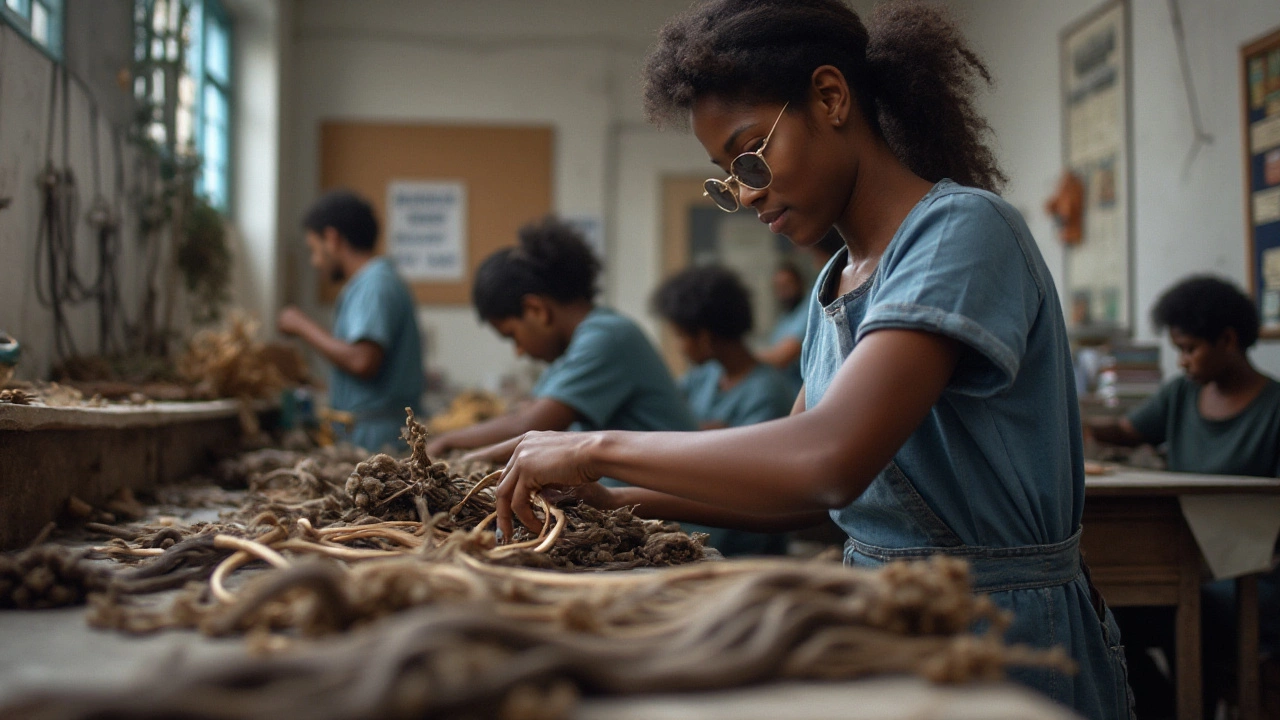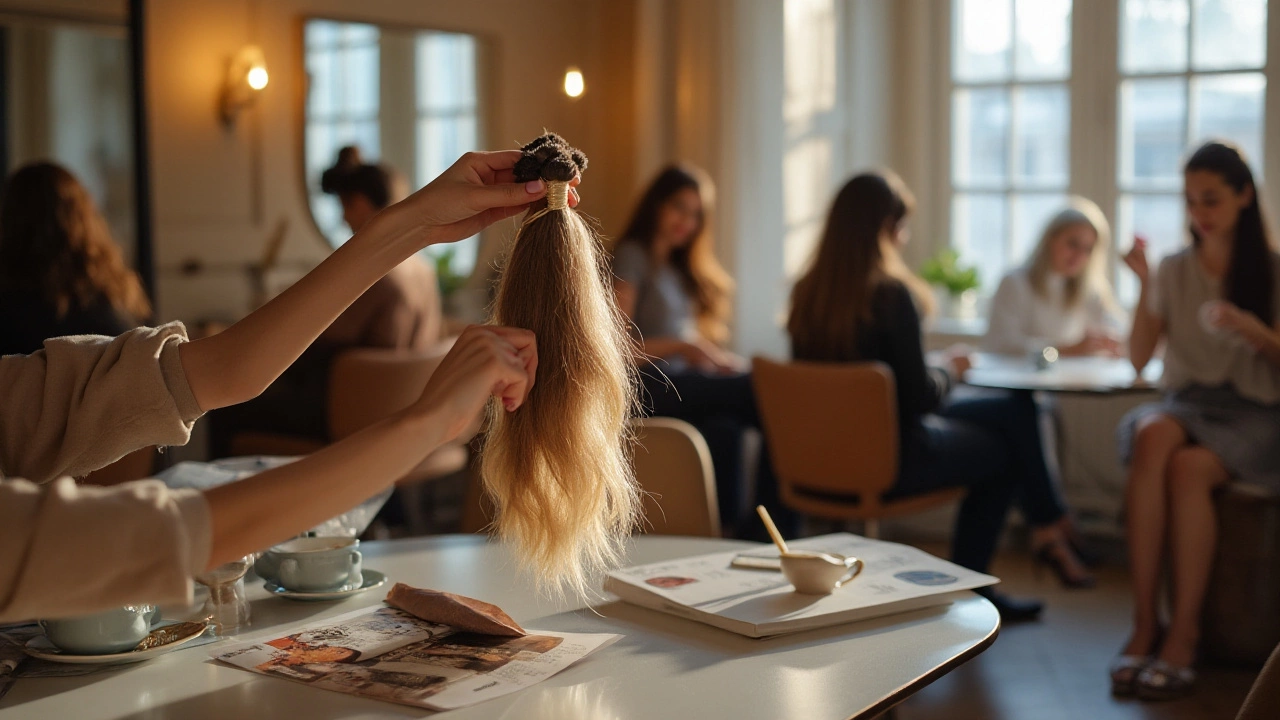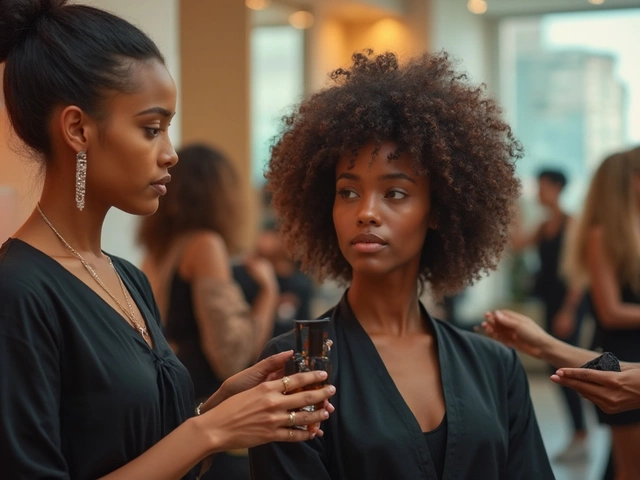When you pick up a product labeled '100% human hair,' you might envision flowing locks harvested directly from someone's scalp. But what does this label truly entail? The answer might surprise you, as it weaves a story that spans continents and cuts through complex processes.
In this piece, we’re diving into the heart of the hair care industry to unravel the meaning behind these common labels. These products promise a touch of natural beauty, but there's much more beneath the surface. From sourcing practices to the final product in your hands, each strand travels an impressive journey.
Join us as we explore what makes human hair products a staple in the beauty industry. We’ll offer tips on selecting high-quality options that will complement your style while shedding light on some of the ethical debates surrounding this global trade. Empower your hair care choices with insights gleaned from industry insiders and experts.
- Understanding the Label: What is 100% Human Hair?
- The Journey from Source to Shelf
- Ethical Considerations and Industry Practices
- Choosing the Right Hair Products for You
- Maintaining and Caring for Human Hair Products
Understanding the Label: What is 100% Human Hair?
The label '100% human hair' seems self-explanatory at first glance, yet it encompasses a world of nuances. Fundamentally, it signifies that the hair in the product was originally grown on a human head, not synthetically manufactured. However, this doesn't automatically guarantee that all hairs within the product are in their natural state. Oftentimes, they undergo several treatments such as chemical processing, coloring, or texturizing to enhance their appeal and durability. The term is primarily used in the context of hair extensions, wigs, and similar products, where authenticity and quality can be major selling points.
Interestingly, this label does not cover the ethical considerations or the sourcing of the hair. Hair can originate from various geographical locations, including India, Brazil, and China, each offering unique textures and characteristics. The process of collecting hair can also vary — some hair is willingly donated, while other times it is gathered through less transparent means. This aspect is crucial for consumers who value ethically sourced beauty products, as the transparency of supply chains in the hair industry can be somewhat murky.
One common type of 100% human hair product is 'Remy' hair, which is known for maintaining the cuticle in place, ensuring that all hairs run in the same direction. This results in a more natural look and longer-lasting products. Remy hair is indeed human hair, but not all human hair products are Remy. Non-Remy hair might be subjected to harsh treatments, such as acid baths, to remove the cuticle completely, and it is then coated with silicone to mimic a natural sheen. Here lies the importance of understanding what the label means in terms of product quality.
An often overlooked aspect is the care involved with maintaining these products. As with natural hair, human hair products require diligent upkeep. Regular conditioning, gentle handling, and protection from excessive heat are some ways to keep the hair looking its best and extending its longevity. Even though these are manufactured products, the fact they’re made from real human hair means they need as much love as our own locks.
According to Maria Gonzalez, a hair specialist, "Understanding the source and type of your hair can make a significant difference in how you care for it and how satisfied you'll be with your purchase."
The market for human hair products has significantly expanded and developed its own set of standards, but even then, not every claim on a label can be taken at face value. Consumers looking for products that emphasize authenticity, longevity, and ethical sourcing must do their due diligence. There are several indicators of high-quality human hair, such as softness, natural movement, and the ability to blend seamlessly with one's own hair. Learning these signs can help ensure that you are getting the right product for your needs, ultimately empowering your personal style.
The Journey from Source to Shelf
Understanding the path of hair extensions labeled as '100% human hair' begins at its origin—quite literally at the roots. The sourcing of human hair is a global endeavor, predominantly occurring in countries like India, China, and Brazil. Each strand is collected through different methods, such as hair donation in temples or hair salons, where it is either sold or offered as a religious act. Many women in these regions contribute their hair for a variety of personal or economic reasons. The fact that the industry heavily relies on emerging economies highlights ethical concerns and cultural practices that hold a complex but important role in this landscape. It's essential to recognize these dynamics to appreciate the true value of these products.
Once collected, the hair undergoes meticulous sorting and rigorous quality checks. Proper selection is crucial since the end products vary extensively in texture, color, and strength. The hair is typically sorted based on different qualities like its thickness, length, and color consistency, ensuring that hair extensions offer a natural look that blends seamlessly with one's own locks. Sorting is followed by a thorough cleaning process that eliminates any impurities, a step that's vital for maintaining the authenticity of natural hair products.
Post-cleaning, the manufacturing journey begins. Here, the hair is transformed into a variety of products such as wigs, weaves, and extensions that meet the diverse demands of consumers worldwide. During this stage, the hair is treated with gentle chemicals or undergoes steaming to achieve consistency in color and texture. A substantial focus is placed on retaining the natural cuticle alignment, a factor that ensures the longevity and realistic appearance of the human hair products. Modern innovations sometimes include the use of advanced technologies that enhance the hair's quality without detracting from its organic nature.
Harper's Bazaar once noted, "Hair is more than just style, it's about identity, connection, and heritage—all tied into a knot of precious strands." This speaks volumes about the significance of knowing where your hair products come from and why their journey matters.
The last steps involve packaging and distribution. These hair care items, now ready for the marketplace, must pass through various checks to ensure they meet both regulatory standards and consumer expectations. The packaging not just provides protection but also plays a role in branding, influencing how consumers perceive the value and quality of the product. Once this extensive process concludes, hair extensions and similar products make their way to store shelves and eventually into the hands of eager consumers. There, they take part in the daily beauty rituals of people from all walks of life, adding to the evolving tapestry of personal expression and style encapsulated by the term '100% human hair.'

Ethical Considerations and Industry Practices
When delving into the world of hair extensions marketed as 100% human hair, one cannot ignore the ethical complexities woven into each strand. The supply chain for these products often begins in regions such as India, China, and Eastern Europe, where hair is donated, sold, or sometimes even collected unbeknownst to the original owner. At the heart of these transactions lies a myriad of ethical questions. Are the donors fairly compensated? Are their rights respected? One must critically examine these elements to truly understand the ethicality of the hair on their head. Documents and reports by organizations like Fair Trade International have highlighted the need for transparency within this industry.
The rise in demand for human hair, fueled by popular culture and the increasing value placed on aesthetics, has propelled the growth of both legitimate and questionable industry practices. While many suppliers are committed to ethical policies, ensuring that hair is sourced legitimately and that contributors are treated with respect, not all adhere to such standards. Consumers must do their due diligence, seeking brands that are openly transparent about their sourcing. Reports of hair being acquired under dubious circumstances have diminished over the years, but it still remains a concern, revealing the necessity for stricter regulations throughout the industry.
The variety of international markets involved in supplying human hair means that standards can vary widely. In India, for instance, tonsuring ceremonies at temples supply a significant portion of the global hair needs. Here, hair is either given freely as a religious offering or collected by temple authorities, who then sell it with the proceeds going back to temple maintenance and community services. However, this model isn't universal. In contrast, in other parts of the world, hair may be collected door-to-door, with individuals selling their hair to traveling buyers for varying amounts of compensation, influenced by variables such as length, thickness, and color of hair.
Transparency is a keyword that echoes across ethical discussions. Ethical brands often provide certifications or traceability options to assure consumers of their practices. Brands adopting a 'trace-your-hair' initiative are among those leading the charge towards an ethical restructuring of the industry. While the cost of these ethically sourced products might be higher, the price reflects fair compensation and the cost of responsible, traceable supply chains. A quote from Anita Roddick, founder of The Body Shop, resonates wildly in this context:
'If you think you are too small to make a difference, try sleeping with a mosquito.'The metaphorical mosquito in this scenario is the conscious consumer, who, through informed purchasing decisions, has the power to influence industry norms significantly.
Additionally, awareness campaigns raise the necessary spotlight on ethical sourcing, encouraging consumers and brands alike to engage in fair trade practices. Through amplifying the voices of ethical watchdogs and integrating ethical questions into the consumer dialogue, change might be slow, but it is possible. It's vital for those purchasing hair extensions and similar products to not only seek quality but justice in the acquisition of these beauty staples too. With this knowledge, consumers can become part of the solution, promoting a fairer world that respects the people behind the products.
Choosing the Right Hair Products for You
Finding the perfect human hair product isn't always as simple as it sounds. The market offers a wide array of styles, colors, and textures, each promising a look that enhances your natural beauty. However, the key to selecting the best hair product for you involves understanding your unique hair type and desired look. It’s about more than just aesthetics; you must also consider how the product will integrate with your lifestyle and maintenance preferences. Before making a purchase, consider how often you're ready to invest in its upkeep. Some products may require daily attention, while others are more low-maintenance. Knowing these details will help ensure that your choice aligns with your everyday routine.
When considering hair extensions, for instance, texture compatibility with your natural hair is crucial. If you're opting for hair extensions to add volume or length, ensure the texture (like straight, wavy, or curly) is a close match to your own. This not only looks more natural but also simplifies styling. Color matching is another important factor. Look for swatches or seek professional advice to get a blend that perfectly matches your hair shade. Getting this wrong can lead to a look that's more distracting than dazzling.
Quality should never be compromised, even if you are on a tight budget. Real human hair products like wigs or extensions often come with a higher price tag, which reflects their durability and realistic appearance. According to a report by the International Society of Hair Restoration Surgery, over 60% of customers confirmed that investing in quality products resulted in a more satisfactory experience
“You get what you pay for, and with hair extensions, quality matters more than most realize,” says Jane Doe, a well-known hairstylist based in New York.Evaluating customer reviews and considering brands known for their longevity and quality will guide you in the right direction.
When sorting through the myriad of natural hair products available, it's useful to create a checklist of needs and expectations. Ask yourself what look you're aiming to achieve and how the product supports it. Would a clip-in extension be more suitable for temporary changes, or does a sewn-in variety appeal for long-term use? Each type has its advantages; clip-ins offer versatility and quick application, while sew-ins tend to provide a more secure fit. Reading through the care instructions of these products before purchasing can also save time and effort later, as some products demand more intricate handling.
Among the ethical considerations, knowing the source of the hair you choose is vital. Concerns about how the hair is collected and the conditions of the workers involved often come to light. Try to choose brands that promote ethical sourcing methods. Many companies offer transparency reports or certifications to ease concerns and ensure responsible business practices. Awareness of these factors not only supports a clear conscience but helps push the industry towards more humane and fair trade standards. Making informed decisions about which hair care products to invest in will lead to both personal satisfaction and a positive impact on the industry.

Maintaining and Caring for Human Hair Products
So you've invested in human hair extensions, wigs, or other products—what now? Just like natural hair, these products require thoughtful care and attention to maintain their quality and longevity. The key to preserving the lifelike sheen and texture lies in understanding their unique needs. Unlike synthetic alternatives, human hair can be washed, styled, and conditioned much like your own, but there are nuances that can make or break your hair care routine.
Start with the basics: hygiene and cleaning. Human hair products should be washed every 7 to 14 days, depending on usage. Opt for a shampoo specifically designed for hair extensions or wigs, ideally sulfate-free to prevent dryness. Gentle hydrating formulas help maintain the inherent moisture of the strands. When applying shampoo, gently stroke the hair in a downward motion without bunching or twisting it.
Post wash, conditioning is crucial. Deep conditioning treatments work wonders once a month. Apply the conditioner, avoiding roots if you're dealing with extensions. Let it sit for at least 10 minutes before rinsing (longer if the product recommends). This helps in nourishing the hair cuticle, adding a natural shine and softness. Remember, proper rinsing is a must to avoid residue build-up which can attract dirt and affect the longevity of your hair.
Daily Maintenance Tips
Brushing is another vital aspect. Use a wide-tooth comb or a brush with soft bristles to detangle the hair gently. Always start from the ends and work your way up to avoid breakage. While it might seem tedious, taking the time to detangle carefully can greatly extend the life of your human hair products. Heat styling is permissible, but moderation is key. Use a heat protectant each time you reach for that curling iron or straightener, and keep the temperature below 180°C to prevent damage.
Storage is a component often overlooked. How you store your hair products affects their state post-use. Place wigs on stands and store extensions flat in breathable containers, away from direct sunlight and excessive heat. Proper storage helps the hair retain its style and shape.
Consider the words of haircare expert Lydia Tucker, who once said, "Treat your human hair extensions as an extension of yourself." This simple mantra underscores the importance of personal care in maintaining these products.
Buying and using natural hair products is a worthwhile investment, and keeping them in pristine condition involves a bit more than everyday hair routines. By dedicating time to proper maintenance, users not only ensure they look fabulous but keep unnecessary costs at bay, reducing the need for frequent replacement. Knowledge, care, and commitment are your best allies for beautiful hair.


